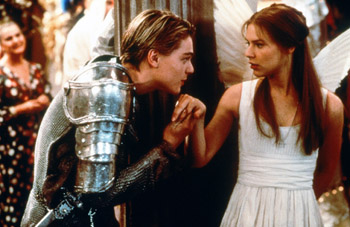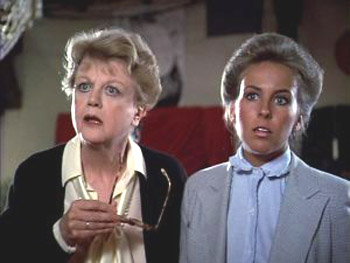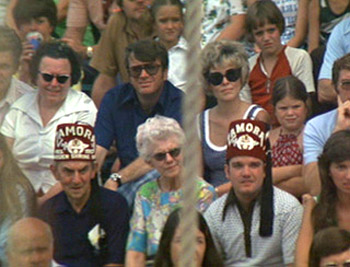May 16, 2008
Screenwriting 201: Gaming the Audience
As I hinted towards the end of Screenwriting 101, game theory applies to more than just the behaviour of the characters in a storyline. The information presented to the members of the viewing audience also constitutes an important part of the storyteller’s consideration.
 When game theory was originally developed by mathematicians, it earned its name because of its application to strategic games — games like chess. A good chess player can figure out all his opponent’s possible moves, but more importantly, how his opponent will react to each of the possible moves he could himself make in response to them. There is a cascading network of possible outcomes, growing exponentially with each move. Based on the probable outcomes from this huge set of possibilities, the chess player then tries to predict which course his opponent will take. And that is at the heart of game theory — prediction. Characters in a narrative can make predictions or not, and be correct in their prediction or not, as it serves the story. But for an audience to predict subsequent events is a storyteller’s anathema.
When game theory was originally developed by mathematicians, it earned its name because of its application to strategic games — games like chess. A good chess player can figure out all his opponent’s possible moves, but more importantly, how his opponent will react to each of the possible moves he could himself make in response to them. There is a cascading network of possible outcomes, growing exponentially with each move. Based on the probable outcomes from this huge set of possibilities, the chess player then tries to predict which course his opponent will take. And that is at the heart of game theory — prediction. Characters in a narrative can make predictions or not, and be correct in their prediction or not, as it serves the story. But for an audience to predict subsequent events is a storyteller’s anathema.
Game theory, as it relates to the choices that characters in an unfolding story make, is really about plot. Except on very rare occasions*, plot is always linear. One event leads to the next or, in the case of game theory, one revelation leads to the next. In other words, the flow of information — something determined by the writer — in turn determines the behaviour of the characters, and the sequence of events (ie, the plot).
But while plot is linear, narrative is anything but. Writers use countless devices to control the information revealed to the audience; this is unrelated to the immutable sequence of events as they supposedly “happen,” and everything to do with controlling the information the audience has, in order to prevent them from predicting the outcome of the story. Even when the ultimate ending to the story is foregone, as in Romeo and Juliet, the way in which the events transpire is not, and it is by withholding this kind of information that writers shape the story and hold the viewers’ interest.
 In other words, gaming the characters determines the story’s plot, but gaming the audience determines the story’s structure. While plot is linear — one event leads to the next — information is doled out to the audience only when it serves to structure the story, to maintain interest, and build anticipation to the climax. Information is essentially given to the viewer in a hodgepodge order relative to the sequence of events, but one that is rationally structured from a game theory (and narrative) point of view.
In other words, gaming the characters determines the story’s plot, but gaming the audience determines the story’s structure. While plot is linear — one event leads to the next — information is doled out to the audience only when it serves to structure the story, to maintain interest, and build anticipation to the climax. Information is essentially given to the viewer in a hodgepodge order relative to the sequence of events, but one that is rationally structured from a game theory (and narrative) point of view.
Flashbacks and flash-forwards are an obvious example. By showing the audience events out of order, information that would make subsequent events obvious can be withheld, making these future events less predictable. The audience’s reaction — their emotional response — is controlled in a way that can be described by game theory. Imagine if Murder She Wrote showed all the events in order: it would start with the scene where we saw the murderer (and his identity) as the crime was committed, then we’d follow Jessica Fletcher as she tried to uncover the perp — all the while knowing who the perp is ourselves. It’s not impossible to make that interesting, but it sure takes a lot of the mystery out of it. But by showing the crime being committed as a flashback at the end, the audience receives this information at the moment when it is most gratifying from a structural perspective.
A flash-forward, on the other hand, gives us a glimpse of future action that is meaningless out of context — the challenge to the audience here is to see if they can determine the how before it’s revealed. Ideally, viewers will be intrigued by the mystery of how a chain of events leads to the future moment they’ve witnessed, and remain guessing about how this future moment came to pass until just before the “future” becomes the “present,” and the narrative leads up to the moment portrayed in the flash-forward. Lost has used both flashbacks and flash-forwards extensively; some have been used to fill gaps in the narrative within a single episode, but some, like the flash-forwards of Season IV, show us moments that offer clues to the direction the narrative is taking, but which are slowly incorporated into the narrative over the course of an entire season, or even multiple seasons.
Which leads to another technique — omission. Few screenplays show every single possible event. Even real-time stories like 24 cut away from important events, keeping information from the audience and building suspense. These events (assuming they really are important) are filled in later, either by flashback or some kind of expository dialogue.
 Speaking of exposition and omission — even filmic narratives are told from a certain perspective. Whether it’s the first person limited style (one that usually follows a single character, and captures all his or her experiences, but omits anything the central character doesn’t experience personally (the “first person” component being fulfilled by narration delivered by the central character, obviously)), or third person limited (in which we see various characters at various times, but know only what selected characters know) or even third person omniscient (in which we follow various characters, and information is filled in by an all-knowing narrator), the type of narrative is strictly controlled for the main purpose of limiting the information presented to the audience.
Speaking of exposition and omission — even filmic narratives are told from a certain perspective. Whether it’s the first person limited style (one that usually follows a single character, and captures all his or her experiences, but omits anything the central character doesn’t experience personally (the “first person” component being fulfilled by narration delivered by the central character, obviously)), or third person limited (in which we see various characters at various times, but know only what selected characters know) or even third person omniscient (in which we follow various characters, and information is filled in by an all-knowing narrator), the type of narrative is strictly controlled for the main purpose of limiting the information presented to the audience.
Take The Big Lebowski, for example. The scenes themselves are delivered from a first person limited perspective: The Dude is in every scene of the film, and we have access to only the information that The Dude has, no more. This is supplemented by narration from an omniscient narrator, one who knows the ending before the storytelling has started, but who keeps this information to himself. (Take a moment and think how often you’ve seen this structure used.) Contrast this with a typical Robert Altman movie — Nashville, for instance. There is no omniscient narrator; everything we experience we experience by observing the characters. But our perspective flits from one member of the huge cast to another, taking in more information than any single character knows, putting together our version of events by examining them from multiple perspectives. Both styles selectively withhold information in order to let the audience know what’s happening while preventing them from guessing what will happen next.
 Variations in narrative style serve only one purpose — whether it’s the number of characters and whose experiences we witness, or the omission of entire events to be filled in later through exposition, or even the temporal inversion of events, so that information about past events is not revealed until it creates the most powerful and effective reaction from the audience, to say nothing of the characters — it’s all in order to structure the story in such a way that a) information is meted out to the audience steadily, to maintain interest, b) information is limited to prevent the audience from extrapolating every situation into the next and making correct predictions, and c) action builds in intensity, to create a climax at the end, to be followed by a resolution.
Variations in narrative style serve only one purpose — whether it’s the number of characters and whose experiences we witness, or the omission of entire events to be filled in later through exposition, or even the temporal inversion of events, so that information about past events is not revealed until it creates the most powerful and effective reaction from the audience, to say nothing of the characters — it’s all in order to structure the story in such a way that a) information is meted out to the audience steadily, to maintain interest, b) information is limited to prevent the audience from extrapolating every situation into the next and making correct predictions, and c) action builds in intensity, to create a climax at the end, to be followed by a resolution.
Life does not happen in three acts. Even events that have a beginning, middle and end are seldom gripping stories at every moment from start to finish. But by pacing the disclosure of events to the audience, if not the events themselves, writers can structure a narrative in a way that maximises the dramatic or comedic impact. And game theory can be used to mathematically comprehend the relationship between the material that a given series of events comprises, and the viewer, whose response to that material can vary wildly based on which bits of information that viewer has received.

*I said that on rare occasions plot was not linear. The only time (that I can think of, anyway) that a plot is not comprised of a linear sequence of events is when parallel sequences of events take place. Hence my tagging of Back to the Future. The audience experiences the events of this movie and its sequels in a linear way, since we follow the events in the order that the central character Marty McFly experiences them; in that sense, there is a temporal linearity to the story, albeit a subjective one.
But taken in their entirety, the events depicted don’t form a line of cause-and-effect happenings. There are two versions of certain periods of time, which branch off due to alterations to a specific moment in the past; some of these timelines are “corrected,” relative the narrative, at least, but one cannot plot the events portrayed onto a single timeline.
Of course, it goes without saying that this kind of paradoxical timeline is absurd; there can never be more than one version of a single moment, so the variations that cause alternate realities to branch off are impossible. But I’m willing to turn a blind eye for the sake of the movie, which, paradoxes aside, is a brilliantly structured movie, and exemplifies gripping storytelling at its best!
“Lost” has done the parallel sequences several times, most notably at the start of Season 2 when Locke, Kate and Jack’s entrance into the Hatch is told over multiple episodes from each character’s vantage points. A minor event in one vantage point (you can hear a muffled scream) as Jack enters the main lab)is further explored in another (In Kate’s perspective we see that the muffled scream is her trying to warn Jack but she can’t be heard over the music blaring in the room. Later in the season we’d get even more on this same sequence from Desmond’s perspective. Of course this is just one example of this structure from “Lost”. There’s an entire youtube video showing everything that happened prior to the crash from well over a dozen characters’ perspectives: http://www.youtube.com/watch?v=0ILPnh4mOKo
PS That was weird you mentioned Jessica Fletcher as I did the same over in the Lost forum on Sucks 2 days ago. I suggested she’d be the perfect person to solve the mystery of the O6’s story from an outsider’s (within the show’s reality) perspective. 🙂
I think the example you cite in “Lost” would constitute parallel storytelling, insofar as the perspective of each character represents an individual timeline, but it still adheres to a single plotline. That is, we see the sequence of events from different points of view at different times, but the plot points still form a linear chain of events.
Only when different events occur at the same place and point in time (like the beginning and end of Donnie Darko, for example, or the alternate version of 1985 in Back to the Future II, or even the hypothetical endings of Clue, Wayne’s World or Run, Lola, Run) does it really constitute two or more timelines. Those are all the examples I can think of at the moment.
I’ve thought of a couple more examples of non-linear plots: L’année dernière à Marienbad, and La Moustache. In these examples (both French surrealism, oddly enough) time is not so much branched off into parallel universes as it loops back on itself like a skipping record, perhaps even existing only subjectively. And Triangle hasn’t been released yet but it looks to be a variation on this as well.